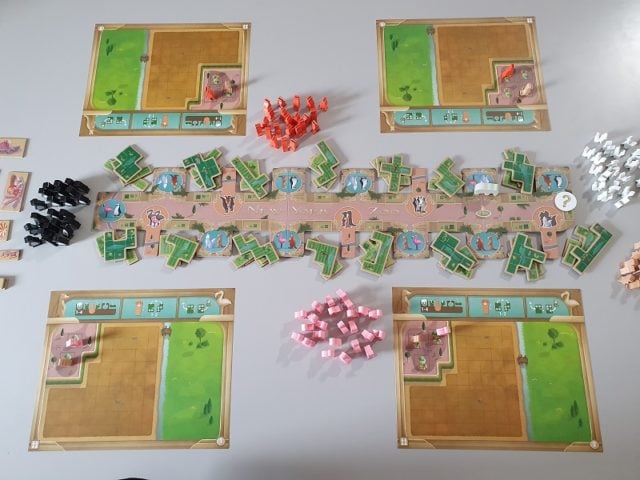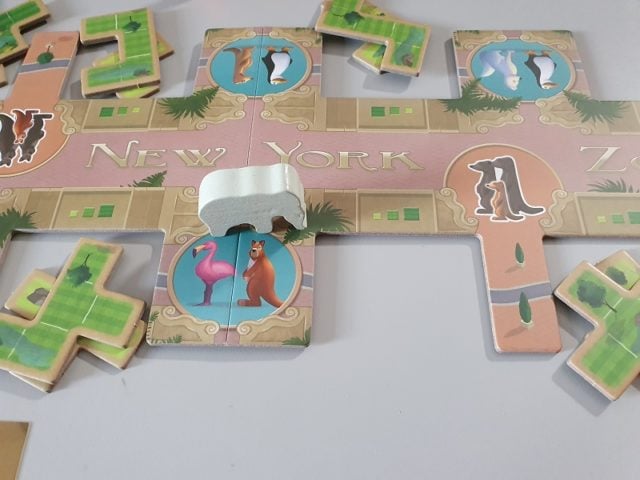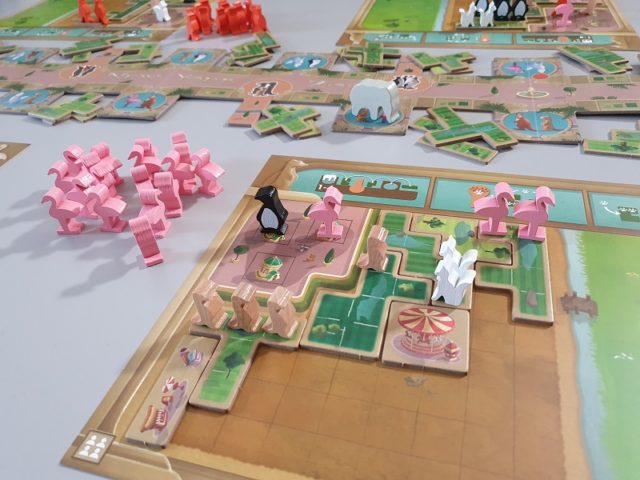You are now ready to build your own zoo in New York! The location is not nothing and the visitors are expected to be numerous. You still have to open the first one, because others have had the same idea. You have the land and already some houses. But you still have to create enclosures for your animals, bring them in but also create some attractions. Not a square meter of land should remain free!
New-York Zoo, what is it?
This very pretty box contains New-York Zoo, a game of Uwe Rosenberg, edited by Super Meeple, which takes up the mechanics of laying polyominoes (tiles with different shapes as in Tetris) dear to the author, and a mechanics of the birth of animals found in Agricola.
Your goal is to be the first to open your zoo to visitors, which means to be the first to cover all the spaces on your player board. On your turn, you can either choose to build an enclosure or bring in animals. It goes without saying that it is forbidden to fill an enclosure with animals of different species! As soon as an enclosure is full, you can free the animals and get an attraction to cover even more spaces on your board.
The first player who has his board full is declared the winner.
Available for € 29.50 at Ludum.fr

How do we play ?
To start, each player takes his individual board which represents the land of his zoo, of variable size according to the number of players to keep the balance. Then place a common board in the center of the table that contains animal boxes and birth tracks, to which are added piles of pens on the 15 empty spaces.
On your turn, you move the elephant pawn on the common board 1 to 4 squares clockwise. This allows you to stop either on an enclosure site to take the 1time tile available, or on an animal space to obtain 2 new animals.

If you decide to take an enclosure, you immediately add it to your zoo wherever you want. You won’t be able to move it anymore. The only constraint is to immediately assign it at least one animal and up to two maximum which can come from another enclosure or / and from one of your dwellings without mixing the species.
If you choose to take animals, you get the two meeples shown on the box that you immediately add to your pens and / or dwellings. The small subtlety is that if you add exactly 1 animal to a pen, you can add a 2e animal of the same species from one of your dwellings. You have to play skillfully with this rule in order to fill your pens as quickly as possible.
But why want to fill them up quickly? Quite simply because New-York Zoo is a race. A race to fill the squares of his zoo with tiles, but also to obtain attractions. As soon as one of your pens is full, you can keep an animal from that pen that you place in one of your dwellings and discard the rest. Then you can choose one of the available attractions. Most are 1 to 3 squares, which is useful for filling spaces that are less or more accessible with polyominoes, but you will also have early access to unique attractions that allow you to cover 4 to 8 squares at once! A big advantage to take over your opponents.

During the first part, we wonder if taking animals is really profitable because we get them only 2 by 2, while the tiles allow, at the start of the game, to immediately cover 6 to 7 squares of your land. This is where the mechanics of births comes in. The common board contains 5 birth lines (one per species). At the end of a player’s turn who crosses the line with the elephant, all players spawn an animal in their enclosures that have at least one pair of the specified species. You must therefore skillfully affect the animals obtained to make them reproduce and obtain attraction tiles. And don’t forget that in order to place an enclosure, you must be able to immediately assign at least one animal to it. This birth system is really clever. Once you figure out how to master it, you don’t see how the elephant moves on the common board the same way. You try to anticipate the moves of your opponents so as not to leave them the tile they want or the possibility of obtaining animals that allow them to enjoy the next phase of birth. The game then takes on a whole new dimension in thinking and strategy, but still remains very accessible and family-friendly.
Available for € 29.50 at Ludum.fr
–
![[Test] New-York Zoo: a board game much smarter and deeper than it looks [Test] New-York Zoo: a board game much smarter and deeper than it looks](https://www.journaldugeek.com/content/uploads/2020/12/bandeau-new-york-zoo.jpg)

